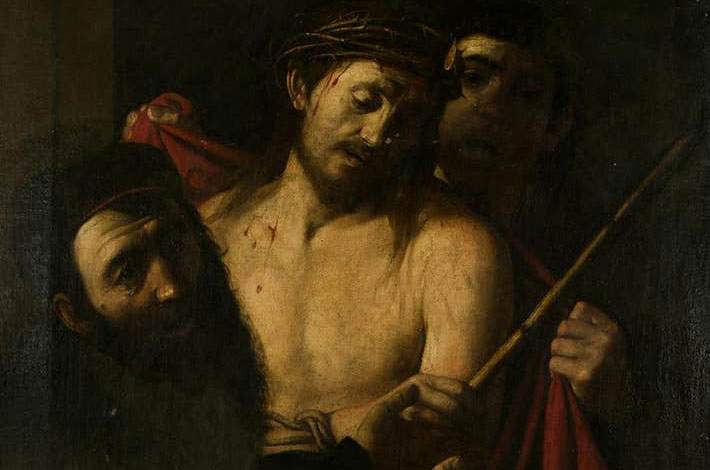The Autonomous Community of Madrid published today, in its official gazette, the resolution of the Community’s Directorate General of Heritage initiating the procedure for the declaration of cultural interest of theEcce Homo attributed by many to Caravaggio: this is the work that was about to go up for auction at the Madrid-based Ansorena house last April 8, with attribution to the circle of José de Ribera. The initiation of the proceedings follows the declaration of non-exportability of the painting, taken as a precautionary measure.
Also published in the resolution was the annex with the reasons that led the Autonomous Community of Madrid to take this action: this is a very relevant text, since the Community offers a summary of the technical assessment of the Prado Museum, which has come out in favor of a probable attribution to Michelangelo Merisi. “According to the technical information issued by the Prado Museum,” the bulletin reads, “the provenance of this painting could be linked to the collecting of the viceroys of Naples in the 17th century. There are well-founded and documentary reasons to consider that it is probably an original work by Michelangelo Merisi di Caravaggio (1571-1610), which in the 17th century was in the collection of Don Juan de Lezcano, secretary of the court of Naples, and later passed into that of the viceroy, the Count of Castrillo, with whom it would have arrived in Madrid. In the inventory of the Lezcano collection the painting was recorded as ’un ecçe homo con Pilato que lo muestra al pueblo, y un sayón que le viste de detrás la veste purpúrea,’ and in that of the Castrillo collection as ’un Heccehomo de zinc palmos con marco de evano con un soldado y Pilatos que le enseña al Pueblo es original de Micael Angel Caravacho’ (as published by Antonio Vannugli in 2009 and by Belén Bartolomé in 1994).”
 |
| Caravaggio (attr.), Ecce Homo (oil on canvas, 111 x 86 cm) |
Therefore, the bulletin further states, “the painting cited in the sources would not correspond to the Ecce Homo attributed to Caravaggio that is currently preserved at the Palazzo Bianco museum in Genoa with the inventory number PB 1638, which was initially identified as the work cited in the texts mentioned above, and about which recent historiography has given rise to a controversy both regarding its autography and its provenance. In addition to these circumstances, the clear parallels in chronology and pictorial language between the declared painting and the stylistic execution of works certified as originals by Caravaggio should be noted. As a result, some clarifying formal similarities are noted, despite the relative state of deterioration of the painting. These similarities are found, for example, between the Christ figure in Ecce Homo and the David in the Galleria Borghese in Rome. Despite the difference in the age of the figures, the anatomical construction of the chest and neck, the slight inclination of the head, the downward gaze, and the shadows over the left half of the face make manifest a genesis that is due to the same author. The figure of Pilate similarly presents important parallels with other works by the author in terms of the models employed and the way of describing their anatomy, as can be seen by comparison with the friar of the Madonna of the Rosary in the Kunsthistorisches Museum in Vienna.”
However, according to the Autonomous Community of Madrid, confirmation of Caravaggio’s autography will require further technical-specialist studies, and the owners will therefore be required to show the work to scholars as per current regulations. The Community lets it be known that in all cases it is a work of great quality: if the autography is confirmed, “to the values of artistic and technical quality that it already presents, it would add the autography of an exceptional Italian painter, who revolutionized painting in a realist sense and had a fundamental influence on numerous artists of the 17th century.” Conversely, “in the event that the property subject to declaration is not finally recognized as a work by Caravaggio, specialists in the field agree that the painting, of high quality, is certainly by one of his most immediate followers.” Therefore, “there is no doubt that the painting constitutes a magnificent testimony to early Italian naturalism, a school that exerted a great influence on all European art.”
Here, then, is the reason for the statement, “the work presents art-historical values of singular importance. According to the informative techniques available today, the work constitutes a testimony to the pictorial excellence and mastery of early Italian naturalism, which exerted a great influence on the 17th-century Madrilenian school of painting. Aspects such as the psychological portrayal of the characters, the realism of the faces, the luministic force that focuses on the body of Jesus Christ, the play of the close-ups of the three characters and the communication that is established with the viewer make this painting a work of great artistic interest.” The bulletin also gives an account of the fact that a direct inspection of the work was not possible at the moment: however, from the photographic images that are available, the work appears dirty and relatively deteriorated. “Future interventions,” the text of the resolution reads, “should tend to heal these aspects and recover the original values of the work.”
 |
| Ecce Homo, Madrid initiates proceedings to affix bond: 'exceptional work' |
Warning: the translation into English of the original Italian article was created using automatic tools. We undertake to review all articles, but we do not guarantee the total absence of inaccuracies in the translation due to the program. You can find the original by clicking on the ITA button. If you find any mistake,please contact us.